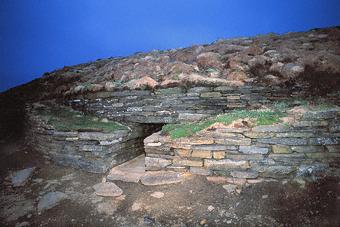| Region : | Orkney | |
|
| Island : | South Ronaldsay | ||
| Town or village : | Burwick | ||
| Grid Reference : | ND 470 844 | ||
| Period : | Late 4th-3rd mill. BC | ||
(Tomb of the Eagles)
CHAMBERED CAIRN
 |
|
The cairn is encased by a rubble mound edged by a wall, roughly D-shaped in plan and possibly originally circular.
The entrance passage, which faces the sea, is 4m long and 0.7m wide. It leads to a main chamber, 8.2m long which is divided into three compartments by pairs of upright slabs. Both end sections had flagged floors and stone shelves.
Three side cells open off the chamber. Inside the tomb, extensive bone deposits were found, both human and animal. Among them, the carcasses and talons of many white-tailed eagles (Haliaeetus albicilla), the largest raptor in Northern Europe. They were possible totemic symbols, like the dog skulls found in Cuween Hill chambered cairn.
The incomplete human remains, at least 338 individuals, were of both sexes, covering all age groups. The two western side-cells contained mostly skulls. Before burial, the bodies had been exposed to the elements to remove the flesh.
Some of the finds can be seen and enjoyed at the little museum in Mr Simison's house and some of them (skulls and white-tailed eagles' talons) are in the Tankerness House Museum in Kirkwall.
Between the tomb and his farm, Mr Simison in 1972 also discovered a burnt mound, a Bronze Age communal cooking place.